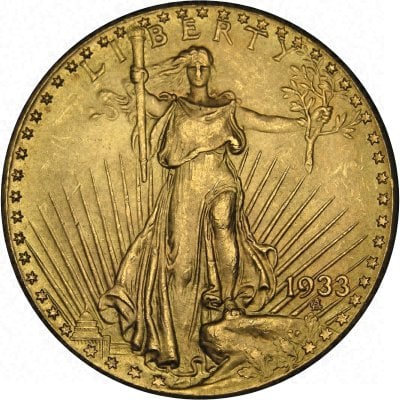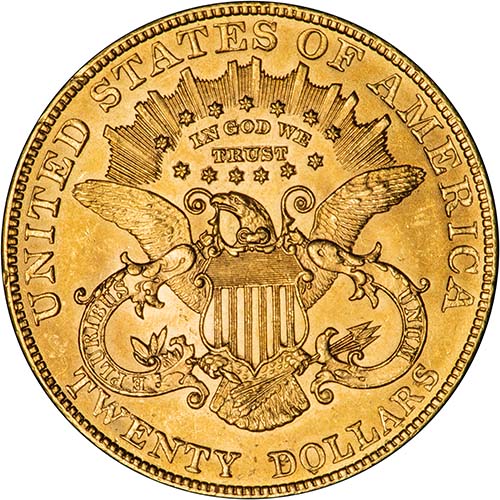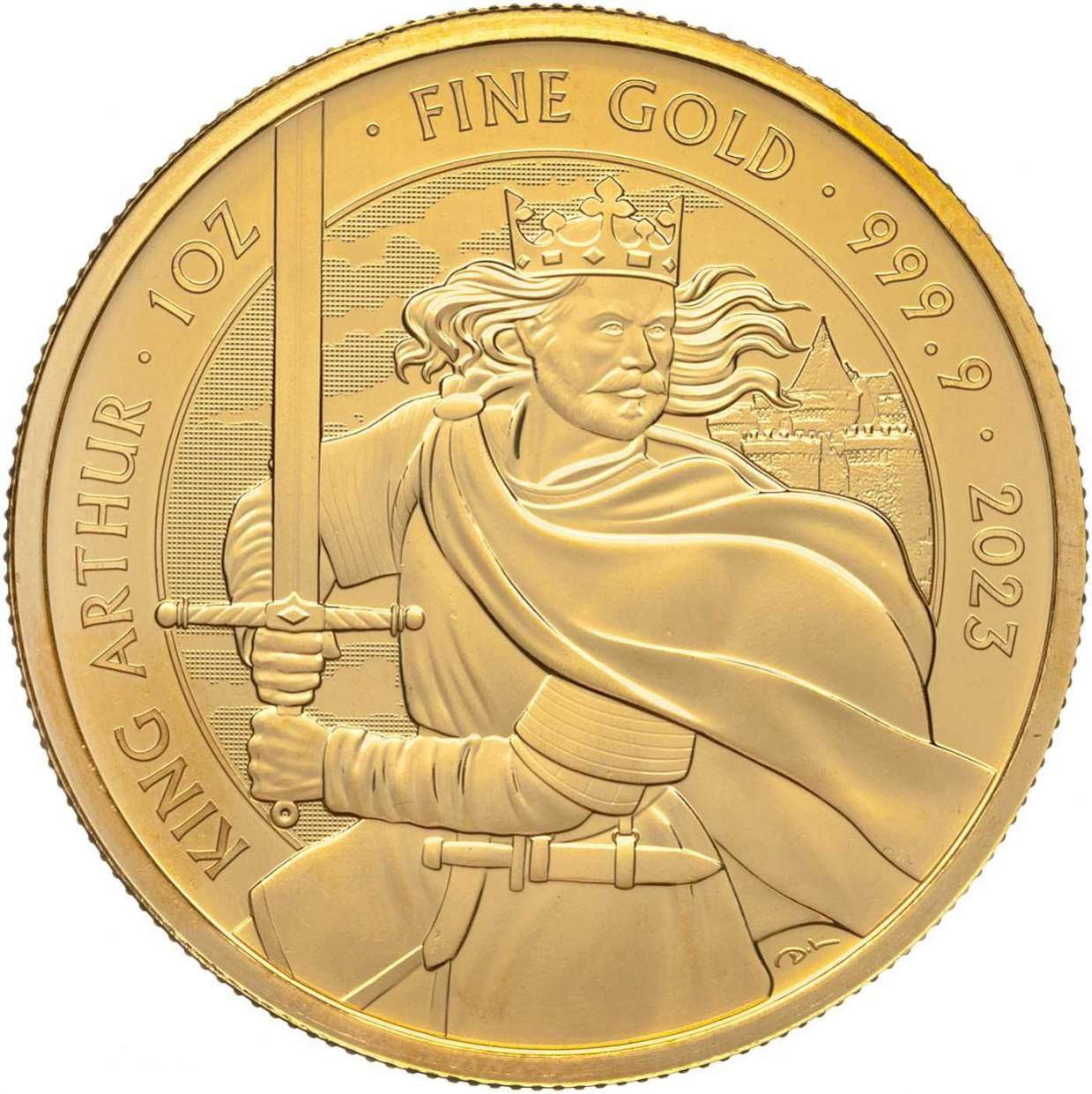1933 American Gold Double Eagle Coins
Synopsis
In 1933, President Roosevelt signed an executive order which resulted in the seizure of 1933 Gold Eagles, making them possibly the most sought after rare coin.
Sypnosis
The 1933 dated gold $20 Double Eagle is a well-known date, mainly because these dated coins were never released into circulation. Out of the 445,500 known to be minted there are only a few known to still be in existence due to the majority being melted down, hence the rarity of the coin.
1933 was also the same year President Roosevelt signed an executive order which took America off the gold standard and recalled gold coins in return for paper money, making it illegal for gold bullion to be owned by private individuals. The confiscation of gold from private investors meant the United States gold reserve was increased which led to the formation of the United Stated Bullion Depository, commonly known as Fort Knox. It was at Fort Knox that a 1933 double eagle was stored and later sold at auction for €7.5 million. (You can read about this more below). The Treasury donated two coins to the Smithsonian Institute, but other coins also escaped the melting pot, for reasons which the US Government says was not sanctioned by them.

The Seizure of 1933 Double Eagles
The Farouk Double Eagle
In 2001, a British coin dealer, Stephen Fenton, was arrested in New York in a sting operation when he tried to sell a double eagle that he claimed had once belonged to King Farouk of Egypt. Criminal charges were eventually dropped against Fenton, but Government held onto the coin arguing that the coin belonged to them. The case was settled however, when the Government agreed to split proceeds of the sale at auction with Mr Fenton, plus $20 to US Government for monetising the coin. The coin was then sold at auction in 2002 at Sotheby's for a record-breaking $7,590,020.00.
Israel Switt
A few years later, the heirs of Israel Switt, a New York Jeweller who died in 1990, discovered 10 Double Eagles in a safety deposit box that had once belonged to Switt. The family contacted the US Treasury in order to get the coins authenticated with a view to selling them, hoping for a similar deal in which the proceeds of any sale would be split between the US Government. However, the US Government instead claimed ownership of the coins and confiscated them, and is not so far offering the same deal that it offered to Stephen Fenton.
The US Government claims that Israel Switt obtained the coins illegally, and that his heirs have no claim on property that was illegally obtained by him. Israel Switt was a personal friend of US Mint Cashier George McCann, and it seems likely that George McCann probably swapped $20 gold pieces of earlier years for the 1933 specimens that Israel Switt came to possess. Nine of these were sold on some years later and subsequently confiscated by the US Secret Service. Israel Switt then apparently claimed that he did not have any more left. Switt could not be prosecuted for the alleged theft because the statute of limitations had expired, but the US Government still maintains that it is the rightful owner of the coins.
The Court Case by Alison Frankel
Everybody Loses
In July 2011, a jury in Philidelphia has found in favour of the US Government. However, the case is subject to a further appeal to a higher federal court.
Here is Alison Frankel’s review of the case...
How the Government Won the $75 ml Double Eagle Rare Coin Case, Alison Frankel, 22nd July 2011, Thomson Reuters News & Insight
In a way, my favorite case of the summer was over before it started. A couple weeks back, I wrote about the start of a Philadelphia federal court trial to determine ownership of 10 exceedingly rare 1933 Double Eagle gold coins. Granted, I have a particular affection for the case because I wrote a book about the legal furor around another 1933 Double Eagle, which ended with the coin being sold for $7.6 million at an auction in 2006. But the Philadelphia trial promised to revive the fascinating story of the 1933 Double Eagles, which were minted just as the U.S. was coming off the gold standard and were never supposed to have made their way into private hands. The daughter and sons of a Philly jeweler named Israel Switt claimed to have found 10 1933 Double Eagles in Switt's safe deposit box long after his death; the U.S. government asserted the coins had been stolen from the Mint and sued to get them back in a forfeiture action. The trial ended this week when jurors sided with the government, finding that prosecutors Jacqueline Romero and Nancy Rue proved the coins had been stolen. Judge Legrome Davis must still rule on whether the government or Switt's family owns the coins, but that ruling is considered a formality: The 10 1933 Double Eagles will return to the U.S. government. That result was foreordained by Judge Davis's omnibus evidentiary ruling on July 5, just before the trial started. Israel Switt's descendents, the Langbord family, wanted to keep the focus of the case on the chaos surrounding the recall of gold coins, and contradictory instructions the Mint received about handling the half-million 1933 Double Eagles that had been minted before it was deemed illegal for Americans to own gold. Their aim was to show that in those tumultuous times, coins might legitimately have slipped out of the Mint. Government prosecutors, on the other hand, wanted to bring in evidence of Israel Switt's suspected involvement in the theft of 1933 Double Eagles from the Mint. To do so, prosecutors listed as trial exhibits a wealth of 70-year-old documents, including Secret Service reports on a 1940s investigation of how the Double Eagles got out. The agents who investigated the case concluded the coins had been stolen by a Mint employee later convicted of fencing coins. The agents also believed, according to the documents, that Switt was involved in the theft. The Secret Service asked the Justice Department to pursue a criminal case against Switt and two Mint employees, but the statute of limitations had run. The Langbords' lawyers, led by Barry Berke of Kramer Levin Naftalis & Frankel, filed a pair of motions to limit the evidence the government was permitted to introducehere and here, raising the sort of arcane legal arguments that can only arise in a case involving events that took place decades ago and documents created by people who are long dead. The Secret Service reports, Kramer Levin argued, consisted of hearsay piled on hearsay, which made them impermissible even under the ancient documents exception to the hearsay rules. And many of the government's other documents, the Kramer briefs assert, failed to satisfy ancient documents requirements, since they weren't original documents but copies of originals that couldn't be located. Judge Davis, however, let just about everything in: the Secret Service reports, documents from Switt's 1934 prosecution for illegal possession of gold coins (not the 1933 Double Eagles, but other coins); Mint records of questionable accuracy; a 1940s ruling in another 1933 Double Eagle case that none of the coins could have left the Mint legally. The judge said he would give the jury instructions on the context in which they were permitted to consider some of the documents, but his ruling amounted to an insurmountable obstacle for the Langbords. There was just too much government evidence casting doubt on Israel Switt's character. The family's lawyer, Berke of Kramer Levin, declined to comment, but his briefs suggest at least one avenue of appeal for the Langbords. As Judge Davis noted in his ruling, there's some disagreement among courts about how many layers of hearsay are permitted under the ancient document exception. The Secret Service reports on Switt-which I read for my book-are loaded with rumors, gossip one witness passed along about others and accounts of interviews in which people recounted conversations with other people. In short, they're loaded with hearsay about hearsay. Judge David decided the reports were nonetheless admissible; I'm betting Kramer Levin will argue that the Secret Service reports shouldn't have come in, and unfairly prejudiced the jury against the Langbords.
Our Thoughts
We believe that the US Government is being heavy-handed, not to mention inconsistent in its treatment of Switt's heirs. If Fenton was entitled to half a share in the proceeds of the sale of the Farouk Double Eagle, then why aren't Switt's heirs? Claiming that the coins were stolen is also a bit dubious. They were probably swapped, not stolen by Switt, with the cooperation of a Mint official. At the time that they were swapped (a common practice with mints the world over at the time) the 1933 Double Eagle was not a rarity, they were just $20 gold pieces, and the Treasury would not have lost out when all the double eagles they had in storage were melted down. The US Government's refusal to offer Switt's family the same deal that they gave to Stephen Fenton is also unfair. Having agreed to settle in Fenton's case, their actions against Switt's heirs is very inconsistent and unjust. By agreeing to settle with Fenton, the US Government set a precedent which they are not willing to adhere to in the case of Switt's family. Hopefully, a US Court will agree with us and allow Switt's heirs to sell their property and share the proceeds with the Government. It would be even better if the Government was forced to return the coins and pay the family's legal bills for forcing them to take this action in order to recover their property.
Legal Gap
Some in the numismatic world have advanced an argument that Switt could have legally obtained the 1933 coins when he was exchanging gold bullion for coins. Although the Mint records apparently show that no 1933 Double Eagles were issued, there were allegedly three weeks in March 1933 when new Double Eagles could possibly have been legally obtained. The Mint began striking double eagles on March 15 and Roosevelt's Executive Order to ban them wasn't finalized until April 5. On March 6, 1933, the Secretary of the Treasury ordered the Director of the Mint to pay gold only under license issued by the Secretary, and the United States Mint Cashier's daily statements do not reflect that any 1933 Double Eagles were paid out.
Related Blog Articles
This guide and its content is copyright of Chard (1964) Ltd - © Chard (1964) Ltd 2024. All rights reserved. Any redistribution or reproduction of part or all of the contents in any form is prohibited.
We are not financial advisers and we would always recommend that you consult with one prior to making any investment decision.
You can read more about copyright or our advice disclaimer on these links.



